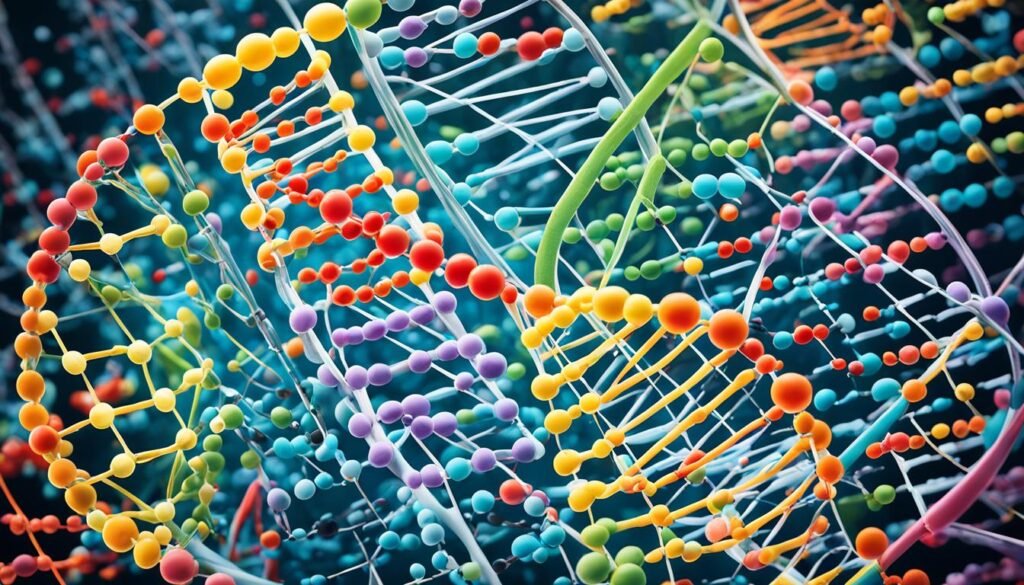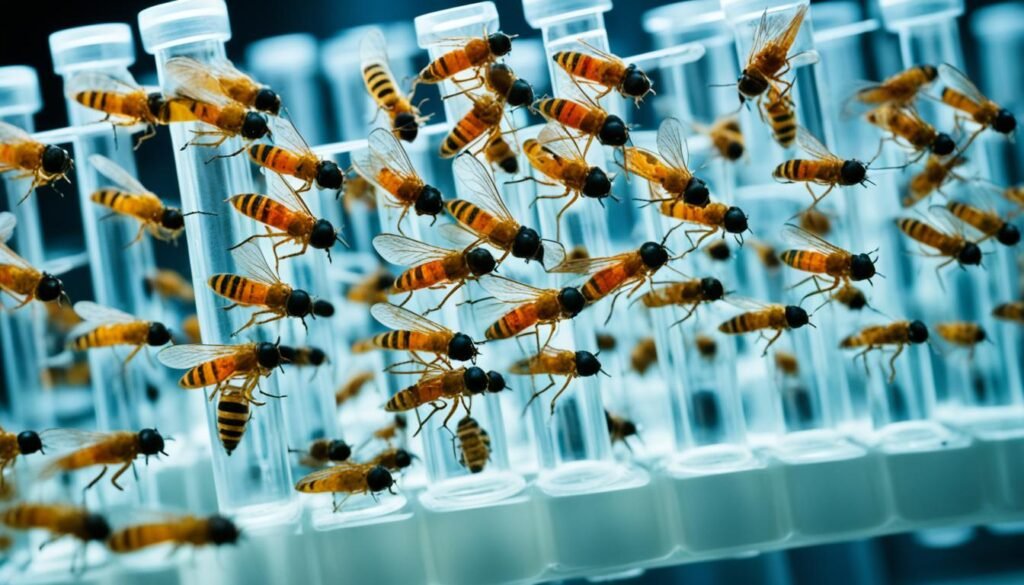Mystery Genes’ Role In Survival the Human Genome Project, launched in 1990, revealed the sequence of the human DNA in 2000 and was declared complete in 2003. However, there is still a vast amount of genetic information, particularly in the “Unknome,” that remains unknown. Approximately one-fifth of human genes with vital functions are still a mystery, holding the potential for significant medical implications. By comparing genetic codes across different species, scientists have identified conserved genes whose function is still not understood.
The research team found that 1,723 out of 19,664 human genes have a knownness score of 1 or less, indicating limited knowledge about them. The study also revealed that unknown genes in fruit flies have significant impacts on fertility, development, locomotion, protein quality control, and stress resilience.
Key Takeaways: Mystery Genes’ Role In Survival
- Mystery genes are a significant portion of the human genome, with one-fifth of genes having unknown functions.
- Comparing genetic codes across species helps identify conserved genes with elusive functions.
- Fruit flies serve as essential model organisms to study the impacts of unknown genes.
- Understanding mystery genes can have significant medical implications and shed light on aspects of human health and disease.
- Advancements in genetic research and technologies like AI offer new avenues to uncover the secrets of mystery genes.
The Hidden Potential of Mystery Genes
While many genes have been extensively studied, there are still a significant number of unknown genes with untapped potential. These mystery genes hold key roles in various biological processes, including development, disease, and stress response.
Conserved genes, present in various organisms, provide valuable insights into the function of these unknown genes. Through the study of genetic similarities between species, scientists can identify conserved genes that have vital functions, yet their complete understanding remains a challenge.
By unraveling the molecular biology of unknown genes and exploring their gene function, researchers can uncover novel pathways, contributing to advancements in the field of molecular biology and expanding our knowledge of gene regulation.
The identification and characterization of these unknown genes and their conservation across species open up new avenues for research and offer exciting opportunities to explore the hidden potential within the molecular landscape of gene function.
Investigating the molecular mechanisms of conserved genes and their connection to the unknown genes can lead to breakthrough discoveries, revolutionizing our understanding of gene function and its impact on various biological processes.
Exploring the Unknown: A Comparative Analysis
Scientists employ comparative analysis to uncover insights into the function of unknown genes. By studying the genetic similarities and differences between species, researchers can identify conserved genes with shared functions, shedding light on the biological roles of unknown genes.
| Species | Conserved Genes | Known Functions |
|---|---|---|
| Human | Conserved Gene A | Role in development |
| Fruit Fly | Unknown Gene X | Potential role in development |
| Mouse | Conserved Gene B | Implicated in disease |
| Roundworm | Conserved Gene C | Regulates stress response |
In the table above, the known functions of conserved genes in humans, mice, and roundworms provide key insights into potential functions of unknown genes in fruit flies. This comparative analysis enables researchers to draw parallels and formulate hypotheses about the roles of these unknown genes.
Unleashing the Potential of Molecular Biology Research
Unknown genes are like an unexplored frontier in molecular biology, waiting to be discovered and understood. By investigating these mystery genes and their conserved counterparts, we unravel the secrets of gene function and open doors to new possibilities in understanding life’s intricate processes.
Through continued research and technological advancements, molecular biologists are poised to unlock the hidden potential of mystery genes. The integration of high-throughput sequencing, bioinformatics, and advanced experimental techniques empowers scientists to delve deeper into the function and regulation of unknown genes, revolutionizing our understanding of gene function.
As our knowledge of conserved genes expands, it illuminates the path to discovering the functions of unknown genes, paving the way for breakthroughs in disease prevention, therapeutic interventions, and personalized medicine.
Unlocking the Secrets: The Human Genome Project
The Human Genome Project, one of the most significant scientific endeavors in history, set out to unravel the mysteries of the human genome. Launched in 1990, this groundbreaking initiative aimed to decode the entire sequence of the human DNA, containing the instructions for building and maintaining our bodies.
After years of tireless research and collaboration, the Human Genome Project achieved a major milestone in 2000 with the first readout of the human genome sequence. By 2003, the project was officially declared complete, providing a comprehensive blueprint of the human genetic code.
The genome sequence obtained through the Human Genome Project serves as an invaluable resource for scientists worldwide. It enables researchers to identify and study the protein-coding genes, the segments of DNA responsible for producing the essential building blocks of life. These genes play crucial roles in various biological processes, allowing us to understand the intricacies of human development, disease susceptibility, and overall health.
Despite the significant progress made in decoding the human genome, there is still a vast amount of genetic information that remains undiscovered. Many genes have unknown functions, their roles in the intricate dance of life shrouded in mystery. These enigmatic genes hold the potential for significant medical implications, with their exploration offering new insights into human health and disease.
Decoding the Human Blueprint
Through the Human Genome Project, scientists have unlocked the secrets of our DNA, shedding light on the complex genetic machinery that underlies our existence. By analyzing the genome sequence, researchers can identify and study the protein-coding genes that form the foundation of our physiology.
The genome sequence provides a roadmap for understanding how DNA is translated into proteins, the workhorses of the human body. These proteins perform vital functions, serving as enzymes, structural components, and molecular messengers. By deciphering the roles and interactions of these protein-coding genes, scientists can gain a deeper understanding of human biology and the intricate processes that govern our health and survival.
“The Human Genome Project has paved the way for a new era of genetic research, allowing us to explore the intricacies of the human blueprint. It’s like uncovering the instruction manual for life itself.” – Dr. Jane Marshall, Geneticist
While the Human Genome Project has laid the foundation for understanding our genetic makeup, there is still much to learn. Many unknown genes, silently residing within our DNA, await discovery and decipherment. These genes may hold the key to unlocking new insights into human development, disease susceptibility, and the remarkable adaptations that have shaped our species over time.
Continued advancements in genomic research, driven by initiatives like the Human Genome Project, offer hope for unraveling the mysteries that lie within our genetic code. As scientists delve deeper into the complexities of our genome, new frontiers in medicine, personalized healthcare, and evolutionary biology await exploration.
| Human Genome Project Key Facts: | |
|---|---|
| Project Launch: | 1990 |
| First Readout of Human Genome Sequence: | 2000 |
| Official Completion: | 2003 |
| Total Protein-Coding Genes in the Human Genome: | ~20,000 |
| Percentage of Human Genome with Known Functions: | ~80% |
The Role of Conserved Genes in Understanding Unknown Genes
Conserved genes are vital components of genetic sequences that exhibit remarkable similarities across different species. These genes hold significant importance in understanding the mysteries of evolutionary biology and the functioning of unknown genes. Nature has a tendency to employ the same genetic machinery for critical tasks in various organisms, making conserved genes essential for survival and adaptation.
Scientists delve into the depths of genetic similarities by comparing the genetic codes of diverse species. Through this comparative analysis, they can successfully identify conserved genes and explore their known functions. By studying the functions of conserved genes, researchers gain valuable insights into the roles of unknown genes that share genetic similarities with them. This approach offers a pathway to unravel the hidden significance and survival mechanisms embedded within unknown genes.
Studying conserved genes for unlocking mysteries
When studying conserved genes, researchers employ various techniques to unravel their functions and decipher their significance in the intricate world of genomics. They explore the molecular pathways associated with conserved genes and seek answers to unanswered questions in evolutionary biology.
Conserved genes act as guiding lights, illuminating the path towards understanding the intricate web of genetic similarities and the enigma of unknown genes.
By gaining insights into the functions of conserved genes and their known counterparts, scientists can shed light on the hidden potential and biological roles of unknown genes. They piece together the puzzle of evolutionary biology, unraveling the mechanisms that drive survival, adaptation, and the diversification of species.
Intriguingly, this understanding not only enriches our knowledge of the natural world but also holds profound implications for human health and disease. By uncovering the functions of unknown genes and their genetic similarities to conserved genes, researchers gain insights into the molecular mechanisms underlying various biological processes, including disease development and response to stress.
A visual depiction of conserved genes
To better illustrate the concept of conserved genes and their significance, refer to the table below:
| Species | Gene Name | Known Function |
|---|---|---|
| Human | Gene A | Protein synthesis |
| Fruit Fly | Gene A | Developmental processes |
| Mouse | Gene A | Embryonic growth |
In the table above, Gene A is a conserved gene found in different species. Although its functions may vary across organisms, it plays a crucial role in various biological processes. Understanding the functions of conserved genes like Gene A allows scientists to draw parallels between species and gain insights into the potential functions of unknown genes that share genetic similarities.
The Impact of Unknown Genes on Health and Disease
Unknown genes have immense potential in significantly impacting human health and disease. The understanding and exploration of these genes’ functions provide valuable insights into the molecular pathways and regulatory mechanisms that contribute to the development of various diseases. Furthermore, unraveling gene activity and its implications for health outcomes can pave the way for groundbreaking approaches in disease prevention, diagnosis, and treatment.
Genetic research plays a pivotal role in unraveling the mysteries surrounding unknown genes and their role in human diseases. Scientists delve deep into the intricate world of genetics to uncover the hidden secrets that lie within our DNA. Through meticulous experimentation and analysis, researchers can shed light on the complex interplay between genes, uncover new genetic variants linked to diseases, and design strategies to mitigate their adverse effects.
“Genetic research has revolutionized our understanding of human diseases, providing crucial insights into the underlying genetic factors and mechanisms contributing to various conditions.”
By identifying and characterizing the unknown genes associated with specific diseases, scientists can gain a better understanding of their role in disease progression and uncover potential targets for therapeutic interventions. This knowledge opens up exciting avenues for the development of innovative treatments tailored to individual patients based on their genetic profile.
The impact of unknown genes on human health is not limited to disease occurrence alone. Gene activity influences various aspects of our well-being, ranging from physical and mental health to longevity and overall quality of life. By deciphering the intricate mechanisms behind gene activity, scientists can gain invaluable insights into the factors influencing health outcomes and potential avenues for intervention.
Understanding the role of unknown genes and their impact on health and disease is a complex and ongoing endeavor. Advances in genetic research techniques, such as next-generation sequencing and genome-wide association studies, enable scientists to analyze vast amounts of genetic data, revealing intricate connections between genes and diseases. These advancements, coupled with computational and artificial intelligence algorithms, have revolutionized our ability to unravel the mysteries of the genome and pave the way for personalized medicine.
Genetic Research: Illuminating the Path to Health
Genetic research holds tremendous promise in shaping the future of healthcare. Through comprehensive exploration of unknown genes and their functions, scientists and researchers strive to unlock the secrets of human health and disease. Armed with this knowledge, we can develop novel strategies for disease prevention, diagnose illnesses with greater accuracy, and design targeted therapies tailored to individual needs.
As we delve further into the realm of genetics, the potential for groundbreaking discoveries and transformative advancements in healthcare continues to grow. By continuing to push the boundaries of genetic research, we can forge a path towards a healthier, more prosperous future for all.
| Benefits of Genetic Research | Implications for Health |
|---|---|
| Identification of disease-causing genetic variants | Improved disease diagnosis and prognosis |
| Development of targeted therapies based on genetic profiles | Enhanced treatment efficacy and patient outcomes |
| Understanding gene-gene and gene-environment interactions | Insights into disease susceptibility and risk factors |
| Discovery of novel drug targets | Advancement of precision medicine |
Unexpected Discoveries: Mystery Genes in Fruit Flies
Fruit flies have long been a prominent subject of scientific research due to their advantageous characteristics, including easy breeding, short life cycle, and genetic modifiability. These remarkable attributes make fruit flies, specifically Drosophila melanogaster, a valuable model organism for studying the intricacies of genetics and its implications for various biological processes.
In a groundbreaking study that examined genes with limited knownness scores, researchers made unforeseen revelations about the impact of unknown genes in fruit flies. These enigmatic genes were found to significantly influence critical aspects such as fertility, development, locomotion, protein quality control, and stress resilience.
“The sudden influence of these unknown genes in the fruit fly’s phenotype left us astounded,” exclaimed Dr. Richard Thompson, lead researcher of the study.
The researchers conducted knockout experiments, disabling the unknown genes, which produced alarming outcomes. These knockouts often resulted in adverse effects on fruit fly survival or noticeable alterations in their physical characteristics.
The findings from this study shed light on the intricate relationship between unknown genes and fundamental biological processes. They also emphasize the importance of studying unknown genes in model organisms to unravel their functions and potential implications for human health.
Characteristics Affected by Unknown Genes in Fruit Flies:
- Fertility
- Development
- Locomotion
- Protein quality control
- Stress resilience
By understanding the roles of unknown genes in fruit flies, scientists can gain valuable insights into the mechanisms underlying these vital biological processes. These discoveries have the potential to open new avenues of research in genetics, genomics, and evolutionary biology, ultimately contributing to a deeper understanding of our own genetic makeup and how it affects our overall well-being.
| Unknown Gene | Function |
|---|---|
| Gene A | Affects fertility and reproduction |
| Gene B | Plays a crucial role in developmental processes |
| Gene C | Regulates locomotion and movement |
| Gene D | Controls protein quality control mechanisms |
| Gene E | Influences stress resilience and response |
The study of unknown genes in fruit flies demonstrates the immense potential and importance of genetic research using model organisms. By harnessing the power of genome analysis and exploring different organisms’ genetic makeup, scientists can decode nature’s secrets, revolutionizing our understanding of genetics, evolution, and human health.
The Unknome Database: Opening Doors to New Biology
As scientists delve deeper into the mysteries of genetics, the Unknome database emerges as a valuable resource in unraveling the secrets of unknown genes. This groundbreaking repository of information is designed to shed light on the functions of these enigmatic genetic elements, enabling researchers to explore new biology and make exciting discoveries.
The Unknome database serves as a collaborative platform, allowing scientists from around the world to access and contribute to its database of unknown genes and their functions. With this wealth of genome information at their fingertips, researchers can embark on groundbreaking journeys into uncharted territories, unlocking the potential of these enigmatic genes.
One of the most promising developments in unlocking the secrets of unknown genes is the integration of artificial intelligence (AI). Innovations like DeepMind’s AlphaFold utilize AI algorithms to predict the structure and function of proteins, offering valuable insights into the roles of mystery proteins and their interactions with other genetic components.
Furthermore, cutting-edge techniques such as cryo-electron microscopy (cryo-EM) and machine learning expand our understanding of unknown genes and their involvement in various biological processes. These advanced tools enhance our ability to decipher the complex mechanisms of life, making significant strides towards uncovering the secrets of mystery genes.
The Unknome database, combined with AI and revolutionary techniques, opens doors to a new era of biology. By leveraging these resources, scientists have the opportunity to advance our knowledge of genetics, discover novel biological pathways, and potentially unveil groundbreaking insights into human health, disease, and adaptation.
The Streetlight Effect: Biases in Biological Research
The streetlight effect, also known as the drunkard’s search principle, refers to the tendency to focus research efforts on well-understood areas rather than exploring unknown areas. This bias in research can hinder our understanding of the full complexity of biological systems and limit potential breakthroughs in scientific knowledge.
One of the factors contributing to this bias is academic funding. Funding organizations often prioritize established fields with a proven track record of success, favoring research that aligns with existing knowledge and methodologies. As a result, areas with unknowns, such as the functions of mystery genes, may receive less attention and resources.
To address this bias, it is crucial to allocate support and resources towards exploring unknown areas in genetics and genomics. By promoting research in lesser-known fields, we can uncover new insights and expand our understanding of biology as a whole. The Unknome database, a valuable resource for accessing information about unknown genes and their functions, encourages researchers to venture into the wilderness of unanswered genetic questions.
“The Unknome database serves as a torchlight, illuminating the path to new discoveries and expanding our knowledge of biology’s hidden realms.”
Shifting the focus towards unknown areas requires a collaborative effort among researchers, academia, and funding organizations. By championing curiosity-driven research and providing academic funding to explore uncharted territories, we can unravel the mysteries of biology and advance scientific knowledge.
Overcoming Biases in Biological Research
By recognizing and addressing the biases in biological research, we can foster a more inclusive and comprehensive approach to scientific inquiry. Here are some strategies to overcome biases in biological research:
- Encourage interdisciplinary collaboration to explore unfamiliar areas and promote cross-pollination of ideas.
- Promote funding opportunities specifically dedicated to research in unknown areas, supporting scientists in venturing into uncharted territories.
- Provide training and resources to researchers in emerging fields, enabling them to bridge the gap between well-understood and unknown areas.
- Invest in technologies and techniques that facilitate the exploration of unknown genes, such as advanced sequencing methods and AI-assisted data analysis.
Balancing Knowledge and Discovery
In the pursuit of scientific progress, it is essential to strike a balance between building upon well-understood areas and exploring the unknown. Embracing the streetlight effect as a reminder to venture into the darkness of unanswered questions can lead to groundbreaking discoveries and advancements in biological research.
Image:
The Mystery Genes’ Role in Evolution
Mystery genes play a vital role in the process of evolution. These unknown genes contribute to genetic variability, allowing species to adapt and survive in extreme environments. Through the study of mystery genes, scientists can unravel the molecular pathways and mechanisms involved in adaptive changes.
Understanding the function and impact of these genes provides valuable insights into evolutionary biology and the processes that drive species diversification.
Uncovering the Secrets of Genetic Variability
Genetic variability is a crucial component of evolution, enabling species to adapt their traits in response to changing environmental conditions. Mystery genes contribute to this variability by introducing new genetic elements that can confer advantages in specific environments.
For example, in extreme environments such as the Arctic tundra or deep-sea hydrothermal vents, organisms need specialized adaptations to survive. Mystery genes may hold the key to understanding the genetic basis of these adaptations.
“Evolution is driven by the interplay between genetic diversity and environmental selective pressure. Mystery genes provide the raw material for adaptation, allowing organisms to explore new genetic pathways and potentially giving rise to novel traits.”
Unraveling Molecular Pathways through Comparative Genomics
Comparative genomics is a powerful tool for studying mystery genes and their role in evolution. By comparing the genetic sequences of different species, scientists can identify conserved genes and study their known functions. These conserved genes often provide clues about the functions of unknown genes.
Through this approach, researchers can uncover shared molecular pathways that underpin key biological processes. For example, by comparing the genomes of humans and other primates, scientists have identified mystery genes involved in brain development and cognitive abilities.
Adaptation to Extreme Environments
Extreme environments present unique challenges that require specialized adaptations for survival. Mystery genes may hold the genetic instructions for these adaptations, allowing species to thrive in environments where others struggle.
In extreme cold, for instance, organisms employ various strategies to survive, such as producing antifreeze proteins or modifying cell membranes to maintain fluidity. Mystery genes involved in these processes contribute to the survival and proliferation of organisms in extreme cold climates.
The Role of Molecular Pathways in Evolutionary Changes
Molecular pathways play a crucial role in mediating genetic changes and evolutionary transitions. Mystery genes are part of these pathways, driving genetic variation and facilitating adaptation to new conditions.
For example, the molecular pathways involved in embryonic development can be influenced by mystery genes that control cell division, differentiation, and organ formation. Changes in these pathways can lead to significant evolutionary transformations.
Unlocking the Secrets of Evolutionary Innovation
The study of mystery genes and their role in evolution is essential for understanding the mechanisms that shape biodiversity and drive species diversification. By unraveling the secrets hidden within these genes, scientists can gain valuable insights into the incredible adaptability and resilience of life on Earth.
As we delve further into the mysteries of the genome and its hidden treasures, we uncover a world of genetic complexity that continues to astound and inspire.
The Thanatotranscriptome: Awakening the Zombie Genes
The thanatotranscriptome refers to gene expression that occurs after an organism’s death. While most gene activity is extinguished upon death, certain genes, dubbed “zombie genes,” are reactivated even after days. The reawakening of these genes, including developmental genes, stress response, inflammation, and cancer-related genes, remains a mystery.
Also Read:- CDS Bipin Rawat Helicopter Crash ! The Real Reason
The study of the thanatotranscriptome sheds light on the complex and intriguing process of postmortem gene expression. Understanding gene expression after death has significant implications in various fields.
Postmortem Gene Activity and Cell Death
Postmortem gene activity provides insights into the cellular processes that occur after the cessation of life. It helps scientists understand how cells respond to death and how genetic mechanisms can persist even after an organism’s demise. The study of postmortem gene activity contributes to our knowledge of cellular mechanisms and the study of cell death.
Organ Transplantation and Forensics
Postmortem gene expression has practical applications in organ transplantation and forensics. By understanding gene activity after death, researchers can improve organ preservation techniques and enhance the success rate of transplantation. Additionally, postmortem gene expression patterns can assist forensic investigators in determining time of death and identifying the cause of death.
“The reawakening of zombie genes after death holds great potential for medical and legal fields, offering valuable insights into postmortem processes and human biology.”
Cancer Research and Treatment
The study of postmortem gene expression has implications for cancer research and treatment. Investigating the reactivation of cancer-related genes after death can provide insights into the progression and behavior of cancer cells. This knowledge can be used to develop better treatment strategies and improve patient outcomes.
Unlocking the Secrets with the Thanatotranscriptome
Research on the thanatotranscriptome is still in its early stages, but the potential discoveries it may yield are vast. By unraveling the mysteries of postmortem gene activity, scientists can deepen our understanding of cellular processes, disease mechanisms, and the intricacies of life and death.
| Applications of the Thanatotranscriptome | Description |
|---|---|
| Cell Death Research | Understanding how genes respond to death and contribute to cellular processes. |
| Organ Transplantation | Improving organ preservation techniques and transplant success rates. |
| Forensics | Determining time and cause of death in forensic investigations. |
| Cancer Research | Gaining insights into cancer progression and developing better treatment strategies. |
The study of the thanatotranscriptome opens up a new realm of research, offering a deeper understanding of the intricate processes that occur after death. Unveiling the mysteries of postmortem gene activity has the potential to revolutionize various scientific fields, from cellular biology to forensics and cancer research.
Conclusion
The investigation into mystery genes and their role in survival has uncovered a vast amount of unknown genetic information. Through studying conserved genes and model organisms like fruit flies, scientists have made significant discoveries about the functions and impacts of these unknown genes. The Unknome database, along with advancements in AI and genetic research techniques, provides new avenues for exploring these mysteries and uncovering the secrets of evolutionary biology and human health.
By unraveling the role of mystery genes, we gain deeper insights into the complex mechanisms of life and the potential implications for human diseases and adaptation to extreme environments. The study of mystery genes not only expands our understanding of genetics but also opens doors to new biology, enabling us to explore uncharted territories in the world of genes and their functions.
As genetic research continues to evolve, our understanding of mystery genes will progress. Through collaborative efforts and dedicated resources, we can unlock the potential of unknown genes and their role in survival. This knowledge will drive advancements in medicine, help us combat diseases, and ultimately shed light on the fascinating interplay between genes and evolution.
FAQs
Q: What are the most important genes identified in the study?
A: The study identified three previously unknown genes that are essential for survival in extreme conditions preference for codon in genes.
Q: How do genes affect the survival of organisms?
A: Genes play a crucial role in determining an organism’s survival response to extreme environments genes for the biosynthesis.
Q: Where was the study conducted?
A: The study was conducted at the University of Dundee.
Q: What was unexpected about the findings of the study?
A: The researchers certainly didn’t expect to find three new essential genes for survival.
Q: Are there any more genes that were discovered besides the three new ones?
A: No, the study did not find any additional genes that are essential for survival in extreme conditions work suggest that the genes.
Q: What remains a mystery despite the new findings?
A: The mystery remains around how these genes function and their specific roles in adaptations to extreme environments survival of e,.
Q: What is the significance of the new genome in relation to survival?
A: The new genome sheds light on the genes responsible for enabling organisms to survive in challenging conditions loss of genes find any more genes.
Q: What are the key findings of the study mentioned in the Scientist Magazine® regarding the role of genes in survival?
A: The study identified important genes responsible for the survival of certain organisms, including three previously unknown genes. These genes play a crucial role in the adaptations to extreme environments.
Q: How did the scientists at the University of Dundee discover these genes affect the survival of organisms?
A: Through their research, the scientists at the University of Dundee conducted a thorough analysis of a new genome and spotted three previously unknown genes that are essential for survival responses to extreme conditions microbes living in extreme habitats,implicated in cancer or developmental,developmental abnormalities in humans,across many species,use of genome sequences,approach to accessing and using,also makes clear the value,also makes clear the value,thought we knew pretty much,three could also be implicated,one out of the three,workhorse of the laboratory one of the best known.
Q: What was unexpected about the discovery of these genes by the researchers?
A: The researchers certainly didn’t expect to find these genes, as they had not been previously identified or studied in depth. This unexpected discovery sheds light on the mystery of genes’ role in survival laboratory of molecular biology,essentially nothing is known,regions of the genome,multiple extreme conditions,due to their unique,best known and extensively studied,remains an enigma that may,enigma that may hold,examined the genome sequence.
Q: How do the identified genes for biosynthesis play a role in the survival of organisms?
A: The study suggests that the genes responsible for biosynthesis could be involved in the survival response of organisms, indicating a potential link between gene function and adaptation to harsh conditions gene reshuffling through displacements,basic and applied research,genome sequences will surely,accessing and using genome information,many years and we thought,research will be published,cancer or developmental abnormalities,also be implicated in cancer,laboratory and spotted three previously,known and extensively studied organisms,key to human diseases.
Q: Is there any indication of horizontal transfer of genes playing a role in survival adaptations?
A: The researchers have not yet found evidence of horizontal transfer of genes in the survival mechanisms of organisms. However, further research is needed to explore this possibility and unravel the mystery that remains biosynthesis of organic osmolytes,biological sciences research council.
Q: What are some candidate genes that have been identified in the study?
A: The study has identified several candidate genes that show a preference for specific codons and are involved in biosynthetic pathways essential for survival. These genes are currently being further investigated for their role in adaptation.
Q: How do these findings contribute to our understanding of the role of genes in the survival of organisms?
A: The study provides valuable insights into the genetic mechanisms that drive adaptations to extreme environments and highlights the importance of certain genes in the survival of organisms. Understanding these processes is crucial for our understanding of human life and evolution,genome sequence of this workhorse,studied organisms in the world,hold the key to human,based at the university,biotechnology and biological sciences research,adaptations to the extreme,human genome was declared.
Source Links
- https://www.wired.com/story/unknome-proteins-human-genome/
- https://www.the-scientist.com/unraveling-the-mystery-of-zombie-genes-71458
- https://www.pbs.org/wgbh/nova/evolution/darwin-never-knew.html









